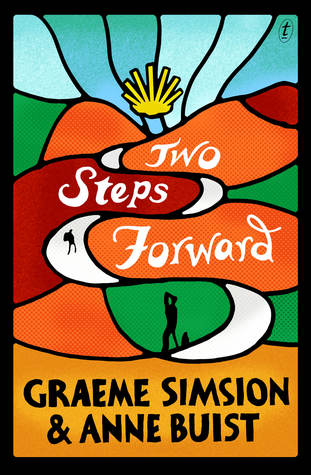Two Steps Forward (Text Publishing 2017) is a novel co-written by Graeme Simsion (of The Rosie Project fame) and his partner, Anne Buist. The structure is a simultaneous narrative, both told in first person: one chapter from the perspective of Zoe and alternating chapters from the viewpoint of Martin. In this way we are shown two – sometimes very different – takes on the same events.
Martin is an engineer from Yorkshire in England; Zoe is an artist from California. The novel opens in Cluny, France, where the two meet by chance. The first thing that Martin and Zoe have in common is that they are both walking the Camino – a two-thousand kilometre journey from Cluny to Santiago in Spain. The Camino – or The Way – is a centuries’-old pilgrim’s walk originally undertaken by those wishing to find spiritual enlightenment or to pay penance or simply to spend a period of isolation and physical activity meditating on the divine. Nowadays it is a popular trek for tourists and pilgrims alike; the route is marked throughout, small hotels and pensions offer accommodation, and individuals and groups meet, separate and meet up again as they journey onwards.
The second thing that Martin and Zoe have in common is that they are both walking to escape their recent past: Zoe is only in her only forties but her husband has just died, and Martin is not much older and is recently divorced with a daughter who is not handling it well.
This is a sort of rom-com of a book. Martin and Zoe meet at the beginning (of the book, and of their walk) but do not immediately like each other, and proceed to walk their separate ways. But over the weeks and months that follow, they randomly bump into each other, and often bumble into misunderstandings that deepen their distrust of each other even while they are clearly connecting on another level. The story is about each of them as individuals – how and why they are walking, and how The Way changes them – but also about how they might come together as a couple, and what that would mean for each of them.
Authors Simsion and Buist have done this walk several times, and that is evident in the telling. In fact, the best part of this book is the descriptions of the walk itself – the scenery, the landmarks along the way, the history of the villages and towns, the hospitality of the locals and the eccentricities and idiosyncrasies of the other pilgrims that they meet on and off during the journey. I found the narrative itself – the relationship between the two people – less compelling, and a little prescriptive, however there were some unpredictable plot points which kept it interesting, and the novel does strive hard to present some wise and important life lessons about finding yourself, opening yourself up to new challenges and opportunities, embracing change and being less judgmental of others.

